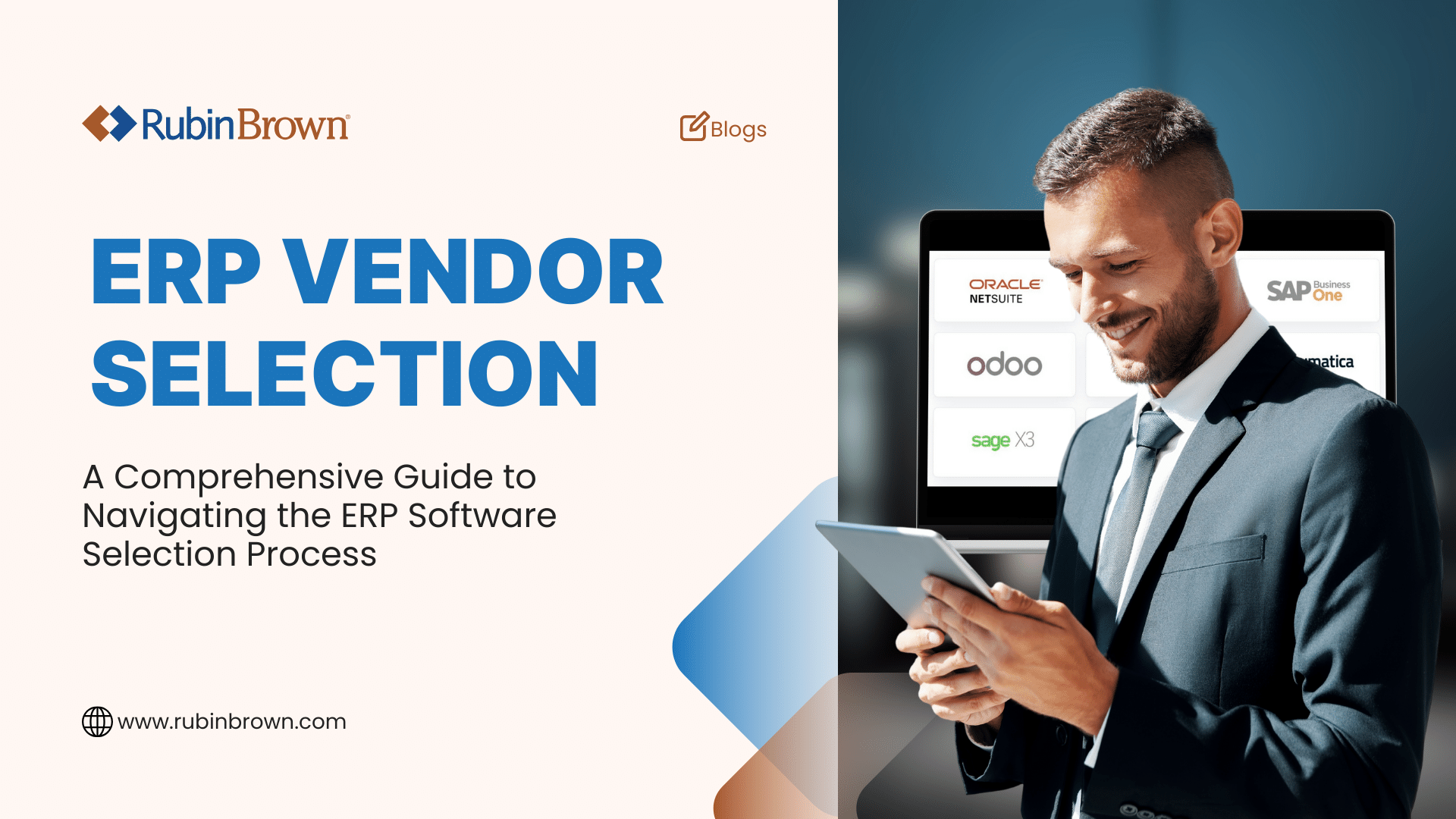The Ultimate ERP Implementation Checklist: Your Roadmap to a Successful ERP Implementation Plan
Embarking on an ERP implementation journey can feel daunting, but a well-structured ERP implementation checklist makes all the difference. This...
6 min read
Admin
:
Jun 10, 2025 2:04:30 PM

Is your ERP proposal setting you up for failure? When over half of ERP projects fail to meet objectives, and some estimates place that number as high as 75%, it's often the vendor proposal that quietly paves the way for budget overruns and disrupted operations. According to Gartner, many of these failures can be traced back to the very first step: a weak ERP proposal that goes unchecked.
Take one $10 million manufacturing ERP rollout that spiraled $3.5 million over budget. The proposal overlooked key training costs, underestimated the data migration effort, and failed to address the integration of legacy systems. It resulted in delays, poor adoption, and an expensive recovery effort.
Proposals are not sales decks—they're project blueprints. Without a clear-eyed review, organizations risk signing on to vague deliverables, generic plans, and hidden costs. Looking closely at the fine print reveals whether a vendor understands your needs or is pushing a template solution. Spotting the red flags early is what separates a smooth ERP transformation from a costly setback.
An ERP proposal should demonstrate a vendor’s deep familiarity with your specific operations, as if they've analyzed your processes and identified key integration points within your supply chain. If the language in the request for proposal (RFP) response feels generic or overly confident about the involved elements it barely details, this is an early red flag.
Vendors using generic brochure language about standard efficiency often demonstrate that they haven't fully grasped your unique workflows or critical business requirements. For example, specific industry needs, such as traceability or compliance, demand detailed solutions in the ERP proposal, not vague promises. Downplaying such crucial, industry-specific elements is always a red flag and can lead to expensive system adjustments post-implementation. A partner pushing a single ERP system for all situations might force your business processes into ill-fitting software, creating a productivity bottleneck.
A superficial project plan, like a simple Gantt chart, often fails to address the realities of an ERP implementation. A reliable chosen partner details milestones for data migration, change management, and integration testing, explaining how the project scope adapts to shifts. If requests for sample project documents yield generic marketing materials, it signals a lack of preparedness for your specific ERP project. For intricate rollouts, a rigid plan lacking contingencies or detailed deliverable tracking suggests that future delays and scope creep are more likely to occur.
True cost transparency in an ERP proposal extends beyond mere numbers; it reflects respect for your organization's financial planning. A comprehensive request for proposal response should clearly itemize all expenses, including licensing, the implementation process itself, integration with various systems, data conversion, comprehensive training, and post-go-live support.
Promises of exceptionally fast ERP system implementation at significantly below-market rates, while appealing in a sales pitch, are early red flags. Such proposals often under-scope essential elements, such as database setup, interface development, and organizational readiness, leading to missed milestones. These low-cost bids often overlook the real costs associated with data cleansing, user acceptance testing, and the necessary refinements inherent in every implementation. An unwillingness to provide a detailed, itemized budget, particularly for training and integration, often means these costs will appear later as change orders.
Be cautious of language in the ERP proposal that portrays involved tasks, such as legacy data migration or multi-currency consolidation, as overly simplistic. These simplifications can obscure genuine project difficulties and risk data integrity or compliance issues with the new ERP system. A proposal for an enterprise resource planning solution that omits potential risk categories and their mitigation strategies suggests inexperience or an overly optimistic sales approach. Unaddressed project complications invariably lead to urgent problems and necessitate further resource allocation.
Impressive dashboards and advanced ERP software features can divert attention from core business goals like improved throughput or reduced operational disruptions. The success of an ERP solution is measured by its ability to seamlessly support team members and key business processes across various departments. A proposal that heavily emphasizes feature lists rather than quantifiable business outcomes, such as projected inventory cost reductions, indicates a misaligned focus. The potential return on investment (ROI) and achievement of specific business goals should be central to the discussion of any new ERP.
ERP system customization can offer a competitive edge, but vague intellectual property clauses in the proposal create risks of future vendor lock-in. If the vendor retains outright ownership of custom code or extensions, your organization might face recurring fees with each ERP software version update. Unclear plans for documentation and source code hand-off can also limit your internal IT team's autonomy. Hesitation to clearly define code maintenance responsibilities and licensing terms is a significant red flag, particularly for cloud-based ERP solutions where platforms change quickly.
A successful ERP integration depends heavily on the skills and experience of the project team, not just the software itself. Transparency from the vendor’s side regarding the team members who will lead workshops, manage data conversion, and configure the ERP system is crucial for building trust and ensuring accountability throughout the project scope.
ERP proposals that showcase only salespeople while keeping functional or technical consultants hidden often lead to disappointment later. Insist on meeting the actual project manager and solution architects who will lead your system implementation and interact with your project leader and steering committee. Biographies that show limited relevant ERP experience or insufficient industry experience in your sector are a concern when selecting the right ERP partner. A vendor unable to confirm specific resource allocation or team location (on-site or remote) introduces risks of poor communication and delays.
While executive buy-in is crucial, the daily adoption of the new ERP system by users relies on line supervisors and analysts from various departments. A proposal that restricts discovery phases to a small leadership group overlooks valuable institutional knowledge essential for the ERP project. Omitting key users from early design workshops can compromise the system's usability and negatively impact adoption rates. A trustworthy partner ensures broad stakeholder involvement to confirm that the chosen ERP solution effectively meets the actual needs of users.
Key pillars of any ERP implementation, such as comprehensive training, meticulous data migration, and robust post-launch support, have a significant impact on the project's ROI. When reviewing an RFP response, carefully assess if the vendor considers these elements integral parts of the scope of work or merely optional additions. This distinction in the proposal reveals a great deal about their commitment to long-term success.
A new ERP system introduces altered workflows that can impact established practices, making comprehensive training vital for a swift recovery in productivity post-implementation. A proposal that only briefly mentions "train-the-trainer" without detailing objectives, time, or metrics is a red flag for future adoption rates. Effective change management is a structured plan involving stakeholder alignment and communication, not just a newsletter. Vendors who minimize these efforts often see user adoption falter, leading to the need for expensive retraining.
Reliable data integrity is fundamental for informed decision-making with a new ERP system. A proposal allocating insufficient time for extracting, cleansing, and validating historical data overlooks the detailed effort required to migrate data correctly. Legacy systems often contain inconsistencies that complicate the data migration process into the enterprise resource planning software. Ignoring these potential setbacks risks serious data issues post-launch, so look for detailed migration strategies and validation milestones in the vendor's plan.
The initial period after an ERP system goes live is critical, as small issues can escalate into significant operational disruptions. A service-level agreement (SLA) in the proposal that vaguely mentions "reasonable effort" without specifying response times or escalation paths is a notable red flag. A robust support model, especially for cloud-based ERP solutions, should outline clear ticket handling procedures, comprehensive knowledge resources, and well-defined upgrade processes. Without such clarity, ongoing support and integration adjustments can become contentious rather than predictable.
Even an apparently thorough ERP proposal can conceal underlying organizational weaknesses in a vendor. The selection process must include due diligence on the vendor’s financial stability, leadership consistency, and client retention history. These factors are important indicators of their long-term reliability as a partner for your new ERP system.
Financial reports, credit ratings, and news of significant mergers can reveal a great deal about an ERP vendor’s financial condition. Declining financial health or frequent, abrupt personnel changes, as noted by existing users, can signal risks to future support for your top ERP choice. Enterprise resource planning is a long-term commitment; a vendor's failure can cause severe disruption and data integrity problems. A stable provider with a clear upgrade path for their ERP software is essential to protect your investment.
ERP success doesn’t begin at go-live. It begins with a proposal that reflects a genuine understanding, a precise scope, and accountable delivery. The red flags outlined above, from vague pricing and weak project plans to mismatched teams and overlooked data risks, are early indicators of trouble ahead.
RubinBrown’s Technology & Management Consulting team helps you identify and mitigate these risks before they escalate. We evaluate each ERP proposal against proven benchmarks to identify hidden costs, misaligned priorities, and gaps in implementation planning, giving you the clarity to make informed, low-risk decisions.
Before you sign anything, schedule a free consultation with RubinBrown’s ERP advisory specialists. We’ll help ensure your next ERP move supports, not disrupts, your business.
-1.png)
Embarking on an ERP implementation journey can feel daunting, but a well-structured ERP implementation checklist makes all the difference. This...

The ERP software selection process determines whether a company gains efficiency or faces costly setbacks. Gartner reports that up to 75% of ERP...

Nearly 66% of organizations that customize their ERP systems report measurable improvements in operational workflows. Yet many still hesitate. The...